Sol Summary – April 7th
Crew 279 Sol Summary Report 07-04-2023
Sol: 5
Summary Title: To sky and beyond
Author’s name: Antoine de Barquin – Crew Commander
Mission Status: Nominal
Sol Activity Summary:
Today, on SOL 5, we conducted an extravehicular activity (EVA) to install a meteorological balloon on the North Ridge plateau. The purpose of the experiment is to expose bacteria to different conditions of temperature, pressure, and UV radiation. To study this we have placed a sensor under the balloon. The mission went well. The balloon is well in place and all the crew returned to the base on time.
This afternoon we continued the usual rhythm with all the experiments. We worked on the mid-rotation video, choosing interesting videos and making new ones to make sure we show how our mission is going. After that, our Crew Astronomer made all the modifications for future observations of the sun with the telescope. The crew Green Hab Officer made new plantations in the green hab and with help chose different plants to make them dry, and see how we can use them after.
It was a successful day for the mission, we have accomplished important tasks for the simulation.
Look Ahead Plan:
It is planned that the astronomer realizes photos of the sun’s prominence. We also plan to process the data from the balloon and test the viability of the bacteria exposed to the balloon parameters. In Sol 6, an EVA is scheduled at Special Region and Lith Canyon for Thomas to continue his radiation measurements in an old area with a lot of fossils and Augustin will make another 3D mapping.
Anomalies in work: Starlink outage
Weather: Sunny, high 17°C/63°F, low -2°C/29°F
Crew Physical Status: Nominal
EVA: See above
Reports to be filed: Journalist report, Greenhab report, Operations report, EVA report, EVA request, Astronomer report
Support Requested: None
Operations Report – April 7th
Crew 279 Operations Report 07-04-2023
SOL: 5
Name of person filing report: Ioana Dimitrova
Non-nominal systems: robotic observatory, Starlink network outage, Opportunity
Notes on non-nominal systems:
Robotic observatory: awaiting for a solution from the manufacturer.
Starlink outage: see Internet section.
Opportunity Rover : see rover section
ROVERS
Spirit rover used: no
Hours: 214,2
Beginning charge: 100%
Ending charge: 100%
Currently charging: yes
Opportunity rover used: yes
Hours: 120
Beginning charge: 100%
Ending charge: 77%
Currently charging: yes
Curiosity rover used: no
Hours: 227.1
Beginning charge: 100%
Ending charge: 100%
Currently charging: yes
Perseverance rover used: yes
Hours: 260.3
Beginning charge: 100%
Ending charge: 77%
Currently charging: yes
General notes on rovers: one of the battery wires on the driver side of Opportunity is corroded out and needs to be replaced.
Summary of Hab operations: Music influence on stress experiment was conducted. Screws on suit 8 were tightened as they were coming a bit loose. Data on all available food was collected for the microbiota experiment.
WATER USE: 16,5
Water (static tank): 389,9
Static tank pipe heater (on or off): off
Static tank heater (On or off): off
Toilet tank emptied: no
Summary of internet: used from 14:00 to 21:00 for experiments and reports. Starlink outage duration 22m 47 sec, followed by significant internet speed drop.
Summary of suits and radios: Radios charging nominal. Suits charging nominal. Screws were tightened on suit 8 as they were a bit loose. Suit 8 (the one with the new battery) was out on EVA today, everything nominal.
WATER USE: 10.56
Heater: Off
Supplemental light: Off
Harvest: 40g mint, 10g lemon balm, 15g thyme, 13g oregano, 19g sage
Summary of ScienceDome operations : bacteria cultures were packaged for balloon experiment. Filming and editing for mid-mission video.
Dual split: Heat or AC, Off
Summary of RAM operations: 3D design and test printing of new and better knobs for the oven following Operations Report of SOL 1 (stem too long to turn in an optimal way). If they work better than old knobs we will ask Mission support if we can replace the old ones. Old knobs still work nominal but could be optimized.
Summary of any observatory issues: see above for robotic observatory. Sun observatory opened but no photos because of cloudy skies. See observatory report for more details.
Summary of health and safety issues: none
Questions, concerns and requests to Mission Support:
We were asked to use power to max in the morning and return to normal in the afternoon, following yesterday’s power outage.
GreenHab Report – April 7th
Crew 279 GreenHab Report 07-04-2023
GreenHab Officer: Augustin Tribolet
Environmental control: Open during day and heater during night
Average temperatures: 77.5 F
Hours of supplemental light: N/A
Daily water usage for crops: 10.5 gallons
Daily water usage for research and/or other purposes: N/A
Water in Blue Tank: 138.7 gallons
Time(s) of watering for crops: 08:00, 19:30
Changes to crops: N/A
Narrative: General watering and maintenance of plants and crops was done, new planting was performed (4 pots of microgreens). The door was left open in the afternoon.
Harvest: 40 g mint, 10 g lemon balm, 15 g thyme, 13 g oregano, 19 g sage
Support/supplies needed: N/A
EVA Report – April 7th
Crew 279 EVA Report 07-04-2023
EVA # 5
Author: Agnès Dekeyser, Crew Executive Officer
Purpose of EVA:
EVA will be focused on conducting a number of experiments that will help us better understand the conditions on Mars. The crew will be exposing bacteria to the MDRS environmental conditions and comparing the results with their analog staying inside the MDRS. This will give us valuable insights into how microorganisms react to the harsh Martian environment and how we can potentially use this knowledge to support future human exploration of Mars.
Additionally, we will be launching a meteorological balloon to take some measurements of atmospheric pressure and temperature. These measurements will help us to better understand the weather patterns on Mars and how they may impact future missions to the planet.
Finally, we will begin our reportage with the parameters tested during the previous EVA. This will allow us to document our findings and share them with the scientific community back on Earth.
Support will be necessary for the installation of the balloon and especially the inflation of it. Which increases the number of people needed to 4.
Start time: 9h06
End time: 11h54
Narrative:
The crew began their journey with a sunny day and a lot of material to carry. Once everything had been loaded into the rovers, the crew drove to their mission destination. Once at North Ridge they had to wait a bit before beginning their mission because of the presence of Martians at the place of their stop. Once the Martians left the place, the crew began their ascent. They walked a little bit all around the North Ridge to find the best way to arrive at the top.
Once at the top, bacteria in their cuvette were placed at the more suitable place to stay for several days. They were attached to a rack with a sign mentioning “Please do not touch”. After that, the cuvettes were oriented to face the sun at any time of the day. One big rock was also placed on top of the rack to make sure that it won’t move during the next few days of exposure to Mars environmental conditions.
Several pictures were taken during the brave ascension of the crew with the heavy material. Once at the top, the crew took a few minutes to observe the view and take pictures despite the short time available due to the work needed to launch the meteorological balloon.
Then, the most ambitious part began : the meteorological balloon was filled with helium and closed very carefully as explained by the manufacturer. One martionaut was holding the balloon while the others were closing the opening using a colson. The latter were covered by tape to prevent them from scratching the ball. The cord was then attached to the opening with several nodes. The opening was folded in two and closed again using colson and tape. The sensor was then attached using the same cord and the balloon was dropped in the air. Some videos and pictures of the launching were taken for the reportage.
Bacteria and the balloon with the sensor attached to it will stay there until the next visit in two days to collect data and check bacteria.
The crew climbed down and took some pictures again before picking up the rovers. Once at the MDRS, they reported the parameters of the four rovers and made a last video of the entry of the crew in the airlock for the reportage.
Destination: North Ridge, because this is the place that the authorities (Utah Division of Aeronautics) have granted us to place our balloon.
Coordinates (use UTM WGS 84): 518500 E, 4251750 N
Participants: Agnès (XO, EVA Leader), Ioana (Engineer), Aglaé (Journalist), Gwen (Astronomer)
Road(s) and routes per MDRS Map: Cow Dung Road 0110 to the cross with Gateway to Candor
Mode of travel: Driving on Cow Dung Road 0110 to the cross with Gateway to Candor then walking to the North Ridge.
Journalist Report – April 7th
CREW 279 – Journalist Report – 07APR2023
Journalist Report : Aglaé Sacré, Crew journalist
SOL 5 : The balloon is in the air!
This morning after a good breakfast, part of the team warmed up with a little sport session to start the day. The EVA can begin.
After several days of preparation of her bacteria, Agnès was able to go and place her bacteria in the Martian environment during the EVA.
We also placed a balloon that will collect meteorological data to bring data to the experiments. We went up to North Ridge to have a view of the balloon from the station.
Back at the station, a nice plate of chili con carne was waiting for us, spicy but perfect to get our strength back! Our Health and Safety Officer even concocted some beautiful and delicious cookies for us!
This afternoon, our astronomer was able to make his first solar observations, so excited to see the results as the simulation progressed!
During this time, we enjoyed playing games and we took the challenge of the MARS puzzle present in the station.
On the program of our evening, a good couscous and especially a game night to spend an evening all together.
EVA Report – April 6th
Crew 279 EVA Report 06-04-2023
EVA #4
Author : Gwenaël le Bussy, Crew Astronomer
Purpose of EVA:
After testing the 2 software for Augustin’s drone, he chose one. To test how the drone reacts to relief, he intends to go to Kissing Camel Ridge to do a mapping of 250m by 229m at low altitude. This place will serve as the first test for low altitude flight. Then he will go to White Rock Canyon where he will do the same thing but with relief on both sides. This time the map will be 250m by 310m. The drone will make a first flight between 20 and 50 meters above sea level to map any obstacles and then a second flight at low altitude. He will need support to launch the drone and to always have a visual view of the drone when Augustin sees the view of the drone through his phone.
The experiment is to see how a drone can be useful to find regions protected from radiation (either for extremophile bacteria or for astronauts themself). To do this, Kissing Camel Ridge W gives a good area with a lot of relief. Then canyon in general can be an interesting place to look for since the water has dragged the rock and potentially offer cavities giving protected area from
Gwen will also test a new reportage camera and focus on obturation time. A fourth person will be needed as technical support, especially for microphone tests (If we hear well on Gwen’s camera). If all these tests are ok, they will start the report.
Start time: 9:13 am
End time: 12 am
Narrative:
First, we went to the Kissing Camel Ridge W (KCRW) ; beginning at 100% battery for both rovers, we ended up with 84% for Spirit and 85% for Curiosity for the 1.01 mile drive. Both rovers were on « M » drive mode and the drive was smooth without speeding. Such consumption seems strange to us and we have a few hypothesis for that behaviour :
Battery consumption is not linear and the first pourcentages are consumed faster
When the battery is « cold » the rover consumes more
Maybe driving mode should be switched to « F » for long distances.
Arriving at KCRW, Augustin started the mapping with the drone while Gwen was testing some settings for best audio and video for reporting. During the mapping, the drone crashed on top of KCRW and the EVA crew had to recover it ; with the approval of the Hab, we started ascending KCRW. Because of the terrain, the EVA crew had to pass by the South side of the KCRW to climb on top. This side of the ridge is in fact in the opposite way the Hab and we lost communication between members of the EVA. Gwen communicated the problem to the Hab then the EVA crew members switched to Channel 2 for communicating on the ridge. In fact, this choice cuts communication with the Hab and we had to inform them. We continued ascending the ridge, reached the top and found the crashed drone. Hopefully, the drone was reparable and Augustin was able to continue the mapping of KCRW.
On top, Gwen was able to communicate again with the Hab (by switching to channel 1) and transmitted all the necessary information to the EVA crew who stayed on Channel 2. Because of the crash, we lost a lot of time and decided with the Hab control to stay on KCRW for the all EVA instead of going to White Rock Canyon after. This allowed Augustin to finish the mapping of KCRW.
At 11:15 AM, the EVA crew decided to start the descent to the rovers by the same route as the climb to avoid risky choices and injuries. The crew returned in time to the Hab after reporting the parameters of the four rovers.
Destination: Kissing Camel Ridge W
Coordinates (use UTM WGS 84): 518000 E, 4249500 N
Participants: Gwen (EVA Leader)(Astronomer), Ttele (HSO), Antoine (Commander), Augustin (GreenHab officer)
Road(s) and routes per MDRS Map: Cow Dung Road 0110
Mode of travel: Drive for a first stop between Kissing Camel Ridge W and E then walking along side of the north face of Kissing Camel Ridge W. Then climbing on top of KCRW


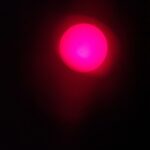
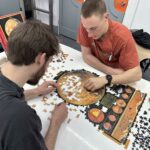
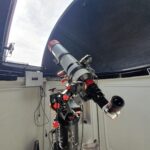
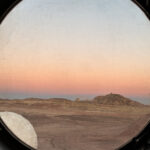
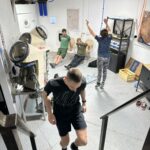

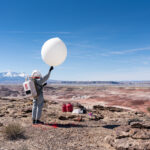

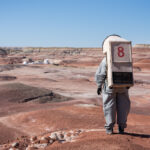
You must be logged in to post a comment.